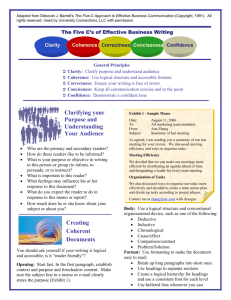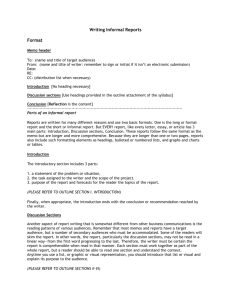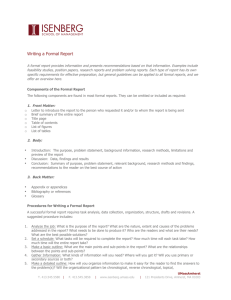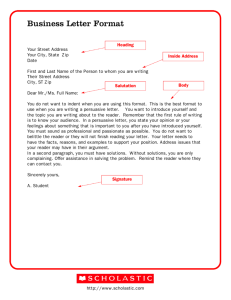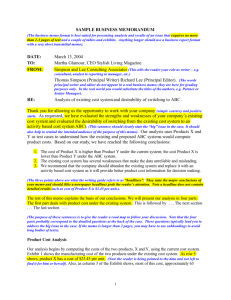Direct Strategy: Effective Business Communication
advertisement
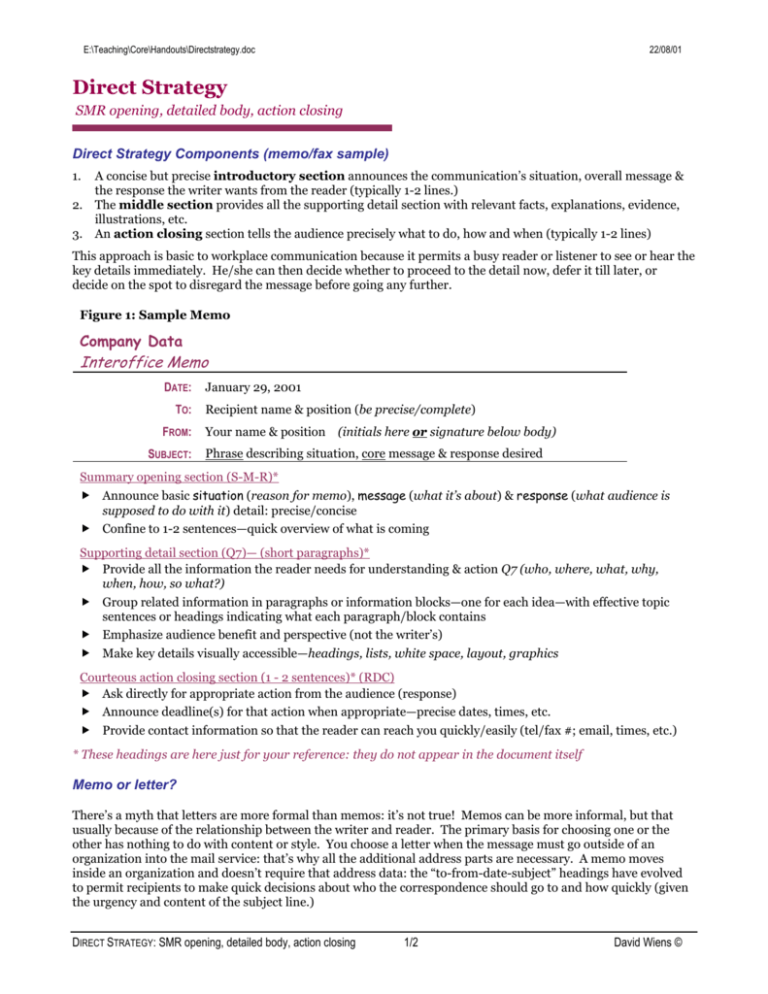
E:\Teaching\Core\Handouts\Directstrategy.doc 22/08/01 Direct Strategy SMR opening, detailed body, action closing Direct Strategy Components (memo/fax sample) 1. A concise but precise introductory section announces the communication’s situation, overall message & the response the writer wants from the reader (typically 1-2 lines.) 2. The middle section provides all the supporting detail section with relevant facts, explanations, evidence, illustrations, etc. 3. An action closing section tells the audience precisely what to do, how and when (typically 1-2 lines) This approach is basic to workplace communication because it permits a busy reader or listener to see or hear the key details immediately. He/she can then decide whether to proceed to the detail now, defer it till later, or decide on the spot to disregard the message before going any further. Figure 1: Sample Memo Company Data Interoffice Memo DATE: T O: FROM: SUBJECT: January 29, 2001 Recipient name & position (be precise/complete) Your name & position (initials here or signature below body) Phrase describing situation, core message & response desired Summary opening section (S-M-R)* ! Announce basic situation (reason for memo), message (what it’s about) & response (what audience is supposed to do with it) detail: precise/concise ! Confine to 1-2 sentences—quick overview of what is coming Supporting detail section (Q7)— (short paragraphs)* ! Provide all the information the reader needs for understanding & action Q7 (who, where, what, why, when, how, so what?) ! Group related information in paragraphs or information blocks—one for each idea—with effective topic sentences or headings indicating what each paragraph/block contains ! Emphasize audience benefit and perspective (not the writer’s) ! Make key details visually accessible—headings, lists, white space, layout, graphics Courteous action closing section (1 - 2 sentences)* (RDC) ! Ask directly for appropriate action from the audience (response) ! Announce deadline(s) for that action when appropriate—precise dates, times, etc. ! Provide contact information so that the reader can reach you quickly/easily (tel/fax #; email, times, etc.) * These headings are here just for your reference: they do not appear in the document itself Memo or letter? There’s a myth that letters are more formal than memos: it’s not true! Memos can be more informal, but that usually because of the relationship between the writer and reader. The primary basis for choosing one or the other has nothing to do with content or style. You choose a letter when the message must go outside of an organization into the mail service: that’s why all the additional address parts are necessary. A memo moves inside an organization and doesn’t require that address data: the “to-from-date-subject” headings have evolved to permit recipients to make quick decisions about who the correspondence should go to and how quickly (given the urgency and content of the subject line.) DIRECT STRATEGY: SMR opening, detailed body, action closing 1/2 David Wiens © E:\Teaching\Core\Handouts\Directstrategy.doc 22/08/01 Restaurant Claim Sample - FULL BLOCK LETTER (formal) 99654 East 49th St. Harbour City, B.C. V3X 2P4 Return address & inside address complete & accurate October 21, 2000 Mr. Don Amonte GODFATHER RESTAURANT 94453 West 49th St. Harbour City, B.C. V9P 2X5 Everything on the page aligned consistently, and effective use of white space makes important information easy to locate Opening paragraph contains all the key details about the accident plus the reason for the letter: the Don knows exactly what this letter is about after reading this very short paragraph Dear Mr. Amonte: On October 18th, waiter Martin accidentally spilled a venison sauce on my new cashmere jacket, damaging it irreparably. As a result, I now require $335 to replace the jacket and pay the dry-cleaning charge. The following day, Alphonso of Little Italy Dry-cleaners (xxx-xxxx) was unable to remove the stain. He explained that the sauce ingredients had a chemical reaction with the fibers in the jacket. The jacket, purchased only last week at Tippler Toppler Tailors for $300, is now unwearable. You will find both the dry-cleaning bill ($35) and a copy of the jacket purchase receipt ($300) enclosed. All the supporting details needed by the audience to answer completely: names, dates, receipts, explanations, phone number & contact at dry-cleaners, etc. Please have a cheque for $335 ready for me to pick up on my way home from work on Friday, October 27th as I will need to replace the jacket for a wedding this Saturday. I can be reached at xxxxxxx during the day or xxx-xxxx in the evenings and on weekends. Thank you. Sincerely, Concise but precise action closing asks directly for payment and notes how that payment should be made, provides easy access telephone numbers but does so courteously Maurice Lepetite Comment: This letter is very direct but courteous. It assumes the reader, a businessman, will respond favorably to its legitimate request, and it provides all the precise details the reader will need to verify the claim, grant the request and file this document in his records. The letter is also audience-focused. The writer does not draw attention to himself: note its very limited use of “I” or “me” and then only when he needs to draw attention to himself. Attention is focused on the audience and the facts of the complaint throughout. DIRECT STRATEGY: SMR opening, detailed body, action closing 2/2 David Wiens ©
